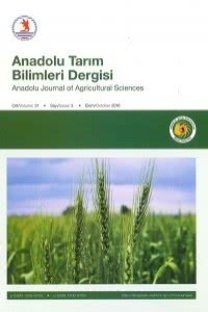Mısır silajının rumende parçalanabilirliğinin belirlenmesi üzerine bir araştırma
silaj, organik madde, ham protein, kuru madde, pepsin, azot, yıkılma, sindirilebilirlik, rumen, mısır
An investigation on determining in situ rumendegradabilities of corn silage
silage, organic matter, crude protein, dry matter, pepsin, nitrogen, degradation, digestibility, rumen, maize,
___
- AOAC, 1984. Official Methods of Analysis (14th cd.). Association of Official Analytical Chemists, Washington, DC, USA, 684pp.
- Demarquilly, C., Faverdin, P., Gcay, Y.. Verile, R., Vermorel, M., 1996. Bases rationnelles de Palimentation des ruminants. INRA Prod. Anim., Hors serie, 71-80.
- Eliman, M.E., Orskov, E.R., 1984, Factors affecting the outflow of protein supplements from the rumen: 1. Feeding level. Anim, Prod. 38: 77-80.
- Mandebuu,P. West, J.W„ Gates, R,N., Hill, G.M., 1998. Effect of hay maturity, forage source, or neutral detergent fiber content on digestion of diets containing Tifton 85 bermudagrass and corn silage. Animal Feed Science and Technology 73 (1998) 281-290.
- McDonald, L., 1981. A revised model for the estimation of protein degradability in the rumen. J. Agric. Sci., Camb. (96): 251-252.
- McDonald, L., Edwards, R.A., Greenhalgh, J.D.F., 1988. Animal Nutrition. 4th. Ed. Logman, London and Newyork.
- Mir, A., Macleod, G.K., Buchanan-Smith, J.G., Grieve, D.G., Grovum, W.L., 1984. Methods for protecting soybean and canola proteins from degradation in the rumen. Can. J. Anim. Sci. 64: 853- 865.
- Orskov, E.R., McDonald, L., 1979. Thr estimation of protein degradability in the rumen from incubation measurements weighted according to rate of passage. J. Agric, Sci., (Camb,), (92): 499-503,
- Orskov, E.R., Hovell, F.D., Mould, F., 1980. The use of the nylon bag technique for the evaluation of feedstuffs. Trop. Anim, Prod. (5): 195-213.
- Orskov, E.R., 1985, Evaluation crop residues and agroindustrial by products using the nylon bag method. In: Batter utilization of crop residues and by products in animal feeding: Research Guidelines. I. State of Knowledge (Ed: T.R. Preston, V.L. Koskila, J. Goodwin and S. Reed) FAO Anim. Prod. And Health Paper (50): 163-184.
- Sarıçiçek, B.Z., Yemler Bilgisi Laboratuvar Klavuzu. OMÜ. Zir. Fak. Yay. Ders Kitabı: 16 (II. Baskı), Samsun.
- Sezer, İ., Gülümser, A., 1999. Çarşamba ovasında ana ürün olarak yetiştirilebilecek mısır çeşitlerinin (Zea Mays 1. indendaia) belirlenmesi üzerine bir çalışma. Türkiye 3. Tarla Bitkileri Kongresi, 15-18 Kasım 1999. Adana.
- Stern, M,D., Satter, L.D., 1984. Evaluation of nitrogen solubility and the Dagron bag technique as methods for estimating protein degradation in the rumen. J. Anim. Sci. (58): 714-724.
- Susmel, P., Stefanon, B., Milis, C.R., Spenghero, M., 1990. Rumen degradability of organic matter, nitrogen and fibre fractions in forages. Anim. Prod. (51): 515-526.
- Van der Aar, P.J., Berger, L.L., Fahey, Jr.G.C., Merchen, N.R., 1984. Effect of alcohol treatment of soybean meal on ruminal escape of soybean meal protein, J. Anim. Sci. 59: 483-489.
- Valentin, S.F., Williams, P.E.V., Forbes, J.M., Sauvant, D., 1999. Comparison of the in vitro gas production technique and the nylon bag degradability technique to measure short- and long-term processes of degradation of maize silage in dairy cows. Anim. Feed Sci. And Tecnol. 78:81-99.
- ISSN: 1300-2988
- Yayın Aralığı: Yılda 3 Sayı
- Başlangıç: 2018
Mısır silajının rumende parçalanabilirliğinin belirlenmesi üzerine bir araştırma
B. Zehra SARIÇİÇEK, ÜNAL KILIÇ
Mısır silajının yem değerleri üzerine bir araştırma
B. Zehra SARIÇİÇEK, ÜNAL KILIÇ
Güneş enerjili kurutucular üzerine karşılaştırmalı bir araştırma
TURHAN KOYUNCU, ABDULLAH SESSİZ
Aydın APAYDIN, Hayati KAR, Cengiz ÖZDEMİR
Bafra ve Çarşamba ovalarında kimyasal girdi kullanım düzeyi ve çevreye etkileri
VEDAT CEYHAN, MEHMET BOZOĞLU, H. Avni CİNEMRE
M. Akif HAŞİLOĞLU, MUHAMMED ATAMANALP
Böğürtlenin (Rubus L.) rengi üzerine dondurarak depolamanın etkisi
Tereyağının mikrobiyolojik kalitesi üzerine kekik ve adaçayı ekstraktlarının etkisi
Ahmet AYAR, Musa ÖZCAN, Attila AKGÜL
TELAT YANIK, E. Mahmut KOCAMAN, MUHAMMED ATAMANALP, Muharrem GÜNEŞ
